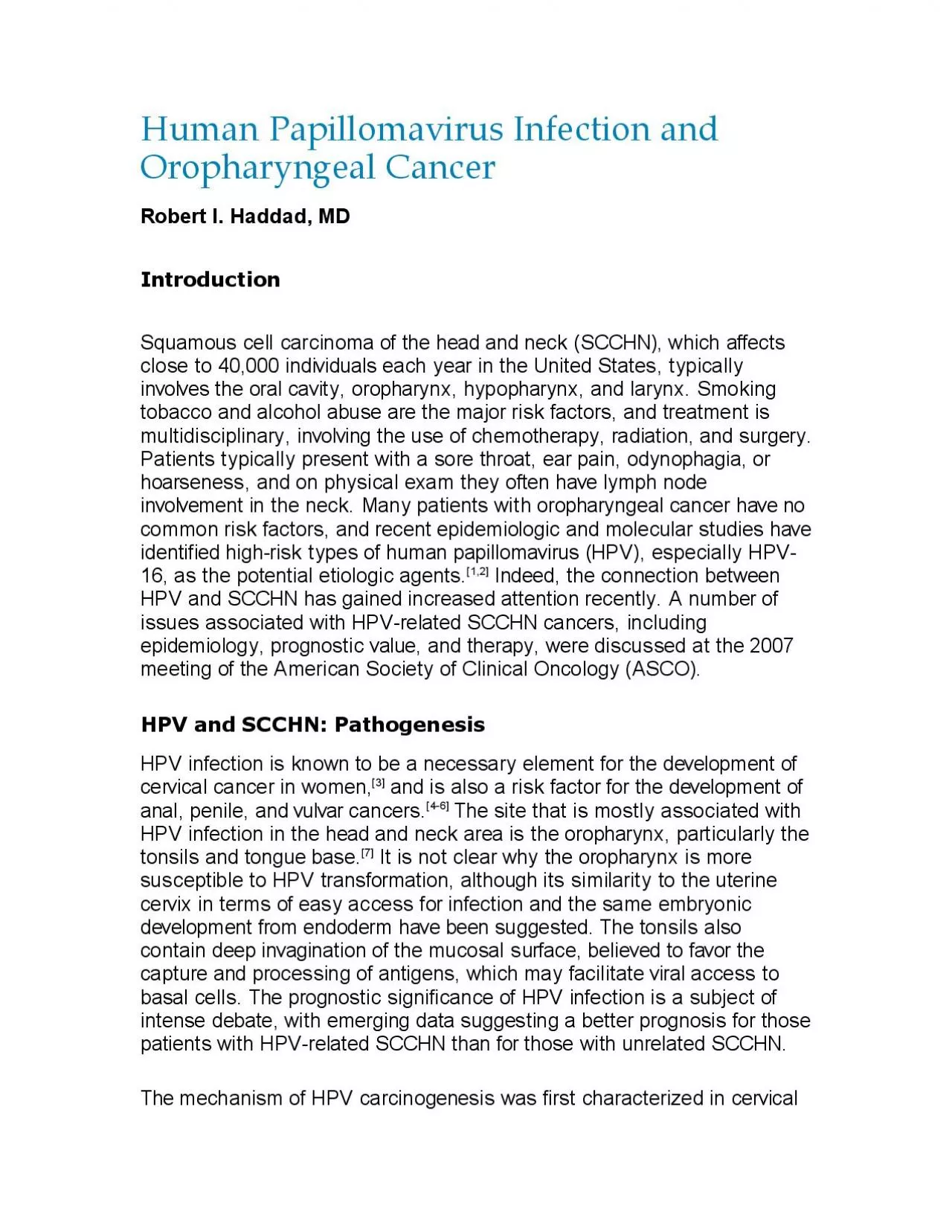

12 Indeed the connec 46 The site that is mostly associated with HPV infection in the head and neck area is the oropharynx particularly the inactivated p53 and pRbrelated proteins permit the ID: 960741
Download Pdf The PPT/PDF document "Robert I Haddad MD Introduction Squamo..." is the property of its rightful owner. Permission is granted to download and print the materials on this web site for personal, non-commercial use only, and to display it on your personal computer provided you do not modify the materials and that you retain all copyright notices contained in the materials. By downloading content from our website, you accept the terms of this agreement.
Robert I. Haddad, MD Introduction Squamous cell carc [1,2] Indeed, the connec [4-6] The site that is mostly associated with HPV infection in the head and neck area is the oropharynx, particularly the -inactivated p53 and pRb-related proteins permit the cell to escape normal check points, with subsequent loss of DNA replication. The simultaneous effects of loss of both p53 and pRb function may lead to the malignant transformation of epithelial cells. This absence of genetic or epigenetic alterations in the p53 and pRb pathways carcinomas usually do not contain any p53 mutations, and occur predominantly in patients with no excessive tobacco and/or alcohol consumption history. These distinctions imply that HPV-positive and HPV-negative carcinomas of t
he head and neck represent distinct entities. Moreover, it has been suggested that the prognosis of patients with HPV-positive tumors is better than that of patients with a smoking related, HPV-negative tumor. The association between HPV infection and other tumor suppressor genes, such as p16, is also of interest. The p16 protein functions as a tumor suppressor by binding to the cyclin D1 CDK4/CDK6 complex, preventing phosphorylation of the Rb protein. Overexpression of p16 protein has been reported repeatedly in HPV-associated cancers, and in a recently published study,[8] only the HPV-positive/p16-expressing tumors -- close to 25% of tumors analyzed -- were the ones associated with favorable prognosis. It is well established that the transmission of
genital HPV infections is associated with sexual contact and performed as part of a multicenter, phase 2 clinical trial conducted by the Eastern Cooperative Oncology Group (ECOG). The clinical results had already been reported, and the purpose of the presentation at ASCO 2007 was to focus on the prognostic value of HPV infection. Patients with newly diagnosed, locally advanced SCCHN of the oropharynx or larynx were unifo and carboplatin AUC 6) followed by chemoradiation (weekly paclitaxel 30 mg/m2 administered concurrently with standard fractionated external beam radiation therapy, total dose of 70 Gy in 35 fractions over 7 weeks). Tumor HPV status was determined by in situ hybridization on formalin-fixed, paraffin -up time of 39.1 months, patients
with HPV-positive tumors had a risk of progression that was 72% lower (hazard ratio [HR] = 0.28, 95% confidence interval [CI]: 0.07-1.0) and a risk of death that was 79% low prospective clinical trial, and may be explained in part by enhanced sensitivity to chemotherapy and radiation. Chaturvedi and his group[11] examined the differences between HPV-related and HPV-unrelated oral squamous cell carcinoma. They did not assess the HPV sta nce trends between 1973- 2003; and (3) overall survival. Cases of SCCHN (N = 58,158) were classified by anatomic site as potentially HPV related (base of tongue, tonsil, oropharynx; n = 16,712) or HPV-unrelated (lip, tongu characteristics: 0. a higher proportion among men; 0. a more advanced initial presentation; and
0. a younger age. -unrelated tumors. The findings from this analysis indicate that the proportion of SCCHN that is potentially HPV-related increased in the United States from 1973-2003, particularly among young males, perhaps due to changing sexual and smoking behaviors. Rampias and his group[12] looked at retrovirus-mediated delivery of short hairpin RNA targeting HPV16 E6 and E7 oncogenes and its potential to induce apoptosis in oropharyngeal squamous cell cancer cell lines. In their model, small hairpin RNAs targeting E6 or E7 genes were delivered by a retrovirus vector to 93VU147T (bearing integrated HPV16 DNA) and 92VU040T (HPV-negative) oropharyngeal cancer cell lines. Flow cytometry analysis was used to assess infection affects prognosis, but
the Fakhry[10] presentation represented the first prospective look at prognosis associated nasopharyngeal cancer and lymphomas. As such, the issue of HPV vaccination[15] will need to be revisited, and future studies will have to take into account all of the HPV-related cancers, not only cervical cancer. Men will potentially need to be vaccinated as well. Indeed, the implications are quite significant from the public health perspective. This year's ASCO presentations by Chaturvedi and Saraiya[11,13] provided more evidence to support our growing sense that the incidence of tonsillar cancer is rising. A rise in incidence is worrisome, and tonsillar cancer is one tumor on a very small list of cancers with such an increase. It is suspected that high-risk s
exual behavior may account for the increase in HPV infection and, ultimately, tonsillar cancer. Since the onset of the HIV epidemic, we have seen an increase in oral sex among teenagers and young adults, probably because this is thought to represent a form of "safe sex" and a worry-f by Rampias and colleagues[12] is promising. I meantime, our focus should be on fuller utilization of the HPV vaccine and public education measures. Conclusion HPV-related head and neck cancer represents a new entity that is now well defined. The practicing oncologist needs to be aware of these new findings, and HPV testing, with PCR or FISH, should now be performed routinely. For now, results will have significant prognostic though not therapeutic implications. Still, cha